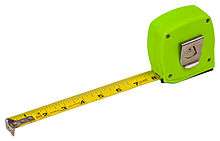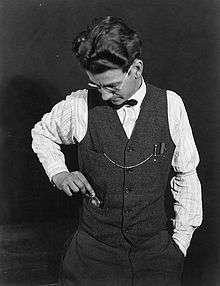Tape measure




A tape measure or measuring tape is a flexible ruler. It consists of a ribbon of cloth, plastic, fibre glass, or metal strip with linear-measurement markings. It is a common measuring tool. Its design allows for a measure of great length to be easily carried in pocket or toolkit and permits one to measure around curves or corners. Today it is ubiquitous, even appearing in miniature form as a keychain fob, or novelty item. Surveyors use tape measures in lengths of over 100 m (300+ ft).
The measuring tapes
Tape measures that were intended for use in tailoring or dressmaking were made from flexible cloth or plastic.These types of tape measures were mainly used for the measuring of the human's waist line. Today, measuring tapes made for sewing are made of fiberglass, which does not tear or stretch as easily. Measuring tapes designed for carpentry or construction often use a stiff, curved metallic ribbon that can remain stiff and straight when extended, but retracts into a coil for convenient storage. This type of tape measure will have a floating tang or hook on the end to aid measuring. The tang is connected to the tape with loose rivets through oval holes, and can move a distance equal to its thickness, to provide both inside and outside measurements that are accurate.[1] A tape measure of 25 or even 100 feet can wind into a relatively small container. The self-marking tape measure allows the user an accurate one hand measure.
History

The first record of a people using a measuring device was by the Romans using marked strips of leather, but this was more like a regular ruler than a tape measure. On July 14, 1868, a patent was filed by one Alvin J. Fellows of New Haven, Connecticut. Fellows' rule, although crude and flimsy, was the first attempt to make a spring tape measure.[2] On 3 January 1922, Hiram A. Farrand received the patent he filed in 1919 for his spring tape measure. Sometime between 1922 and December 1926, Farrand experimented with the help of The Brown Company in Berlin, New Hampshire.[3] It is there Hiram and William Wentworth Brown began mass-producing the tape measure.[4] Their product was later sold to Stanley Works.
Design
The basic design on which all modern spring tape measures are built can trace its origins back to an 1868 patent by a New Haven, Connecticut resident named A. J. Fellows. According to the text of his patent, Fellows' tape measure was an improvement on other versions previously designed.[5]
The spring tape measure has existed since Fellows' patent in 1868, but its usage did not become very popular due to the difficulty in communication from one town to another. In the early 1900s, carpenters began slowly adopting H. A. Farrand's design as the one more commonly used, which is the design all modern tape measures used today.
With the mass production of the integrated circuit (IC) the tape measure has also entered into the digital age with the digital tape measure. Some incorporate a digital screen to give measurement readouts in multiple formats. An early patent for this type of measure was published in 1977.[6]
There are also other styles of tape measures that have incorporated lasers and ultrasonic technology to measure the distance of an object with fairly reliable accuracy.
United States
Justus Roe, a surveyor and tape-maker by trade, made the longest tape measure in 1956, at 600 feet (183 m).[7]
The Northern Virginia Surveyors Association presented the 600-foot, gold-plated surveyor's tape measure to Mickey Mantle in 1956.[8]
Some tapes sold in the United States have additional marks in the shape of small black diamonds, which appear every 19.2 inches (48.77 cm). These are used to mark out equal spacing for joists (five joists or trusses per standard 8-foot (243.8 cm) length of building material).
Many tapes also have special markings every 16 inches (40.6 cm), which is a standard interval for studs in construction. Three spaces of 16 inches make exactly 4 feet (121.9 cm) which is the commercial width of a sheet of plywood, gyprock or particle board.
It should also be mentioned that dual scale tapes are slowly becoming commonly sold in the United States. For example, in some Walmarts there are Hyper Tough brand tapes[9] available in US customary units and Metric units.
United Kingdom
Tape measures sold in the UK often have dual scales for metric and imperial units. Like the American tape measures described above, they also have markings every 16 in (40.6 cm) and 19.2 in (48.8 cm).
Canada
Tape measures sold in Canada often have dual scales for metric and imperial units. All tapes in imperial units have markings every 16 in (40.6 cm), but not at every 19.2 in (48.8 cm).
In surveying
Tapes are used in surveying for measuring Horizontal, vertical or slope distances. Tapes are issued in various lengths and widths and graduated in variety of ways.[10] The measuring tapes used for surveying purposes are classified in 4 types according to the material from which they are manufactured:
- Linen or Cloth Tape. It is made of linen cloth with brass handle at zero end whose length is included in the tape length. It is very light and handy, but cannot withstand much wear and tear. So it cannot be used for accurate work. It is little used in surveying except for taking subsidiary measurements like offsets.
- Metallic Tape. The tape is reinforced with copper wires to prevent stretching or twisting of fibers and is then called as metallic tape. They are available in many lengths but tapes of 20 m and 30 m are more commonly used.[11]
- Steel Tape. It is made of steel ribbon varying in width from 6 mm to 16 mm. It is available in lengths of 1, 2, 10, 30 and 50 meters. It cannot withstand rough usage and therefore it should be used with great care.
- Invar Tape. It is made of an alloy of steel (64%) and nickel (36%). It is 6 mm wide and is available in lengths of 30 m, 50 m and 100 m. It is costly and delicate and should be thus handled with great care.[12]
References
- ↑ Aird, Forbes (1999). Mechanic's guide to precision measuring tools. Osceola, WI: MBI Pub. Co. p. 18. ISBN 9780760305454.
- ↑ Today in History. "First Spring Tape Measure", Connecticut, 14 July 2009. Retrieved on 24 March 2015.
- ↑ Hiram A. Farrand Inc. (Dec 1930). Popular Science. Popular Science Monthly. Retrieved 3 November 2011.
- ↑ Walter W. Jacob (Sep 2004). "Stanley Advertising and Imprinted Tape Rules". The Chronicle of the Early American Industries Association. Retrieved 3 November 2011.
- ↑ Letters Patent No. 79,965. Text Retrieved 26 February 2006.
- ↑ "Electronic read out tape measure". Google Patents. 21 June 1977. Retrieved 3 January 2015.
- ↑ "Suffolk County News, Via the Grapevine" (PDF). 13 July 1956.
- ↑ Jane Leavy (2010). The Last Boy: Mickey Mantle and the End of America's Childhood. HarperCollins. p. 91. ISBN 978-0-06-088352-2.
- ↑ HYPER-TOUGH
- ↑ official website of "Integrated publishing",http://www.tpub.com/engbas/11-26.htm
- ↑ book on surveying by "Dr. B.c Punmia and Ashok Kumar Jain"
- ↑ surveying volume 1 by Prof. C.L Kochher, page no. 17
External links
- Various types of measuring tapes and construction materials
-
 Media related to Tape measures at Wikimedia Commons
Media related to Tape measures at Wikimedia Commons